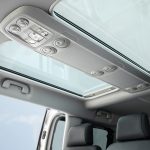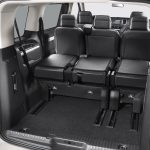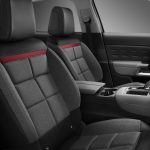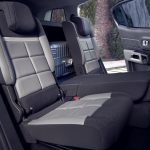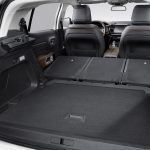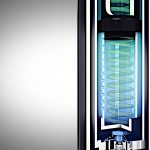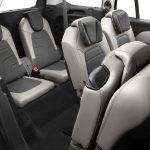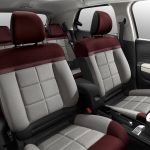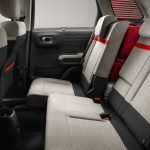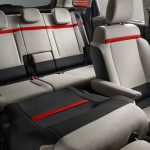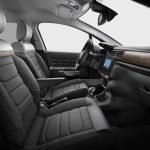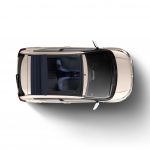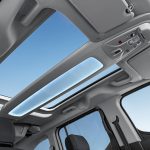
(english text below, after the gallery)
Die Pressemitteilung der Citroën Deutschland GmbH:
Komfort steht bei Citroën seit über 100 Jahren im Mittelpunkt – Episode 2: Innenraumkomfort
* Vom Traction Avant bis zum C5 Aircross SUV: Komfort steht bei Citroën stets im Mittelpunkt
* Programm Citroën Advanced Comfort® als das Markenzeichen aktueller Modelle
* Innovative und flexible Innovationen sorgen für Innenraumkomfort „à la Citroën“
Einzigartiger Komfort auf Basis zahlreicher Innovationen ist seit der Unternehmensgründung im Juni 1919 eines der Markenzeichen von Citroën. Revolutionäre Federungstechnik, bequeme Sitze, ergonomische Bedienelemente, aerodynamische Linienführung und neuartige Materialien im Innenraum − die innovativen Lösungen prägen bis heute den typischen Citroën Komfort.
Mit dem aus vier Säulen bestehenden Citroën Advanced Comfort® Programm bündelt die Marke ihre Expertise auf dem Gebiet des Komforts:
* Fahrkomfort: Störfaktoren werden durch spezielle Innovationen in den Bereichen Federung, Dämmung und Sitze herausgefiltert, damit die Insassen sich wie in einem Kokon fühlen;
* Innenraumkomfort: Der Innenraum überzeugt mit einem großzügigen Raumangebot, praktischen Ablagen und pfiffiger Ausstattung;
* Bedienkomfort: Optimale Bedienung dank intuitiver Technologien, nützlicher Fahrhilfen und moderner Konnektivität;
* Komfort für Geist und Seele: Fokus auf die wirklich wichtigen Informationen. Der Innenraum strahlt ein beruhigendes Ambiente aus.
Diese vier Bereiche stützen sich auf historische Innovationen und verdeutlichen, dass Citroën seit über 100 Jahren für besonderen Komfort steht. Sie werden in insgesamt vier Episoden vorgestellt. In der ersten Episode stand der Fahrkomfort im Mittelpunkt, nun folgt der Innenraumkomfort.
Praktischer und flexibler Innenraum
Citroën entwickelt stets innovative Technologien, um den Innenraum bestmöglich von der Außenwelt abzuschirmen und allen Insassen maximalen Komfort zu bieten. Neben den neuesten Technologien sorgen auch praktische Ausstattungen, raffinierte Ablageflächen und ein hohes Maß an Variabilität für Wohlbefinden an Bord.
Schon im Jahr 1923 lässt der praktische, vielseitige Citroën Typ B2 die Wahl zwischen vielen Sitzplätzen oder einem größeren Gepäckraum, ebenso wie der zweisitzige Citroën Typ C3 „Torpedo“, welcher mit einem zusätzlichen Notsitz hinter dem Fahrer ausgestattet ist, um je nach Bedarf eine dritte Person oder mehr Gepäck mitnehmen zu können.
In den 1930er Jahren und darüber hinaus wird der Citroën Traction Avant in verschiedenen Sitzkonfigurationen angeboten. Zur Baureihe gehört eine siebensitzige Version mit langem Radstand und ein Modell mit einer nach oben zu öffnenden Hecktür – vermutlich die erste Serienlimousine mit Heckklappe weltweit.
Auch der Citroën 2CV wartet mit innovativer Konstruktion im funktionalen Innenraum auf. Mit herausnehmbaren Sitzen, Schiebedach, flachem Fahrzeugboden und erweitertem Kofferraum setzt das legendäre Modell zu seiner Markteinführung Maßstäbe. Bereits lange vor der Markteinführung von sechs- oder siebensitzigen Modellen überzeugen die DS und der Citroën CX als Kombiversionen mit pfiffiger Sitzkonfiguration.
Auf Automobilsalons präsentiert Citroën einzigartige Concept Cars, die den Innenraumkomfort in den Vordergrund rücken und einen Vorgeschmack auf zukünftige Serienversionen bieten. Die Citroën Karin aus dem Jahr 1980 besticht als pyramidenförmige Dreisitzer aus Verbundmaterialien durch innovative Ablagen, ausgeformte Sitze, ein Kombiinstrument mit Bediensatelliten und Tasten am Lenkrad.
Seit jeher legt Citroën das Augenmerk zudem auf Ergonomie und praktische Innenraumkonzepte. Hierzu zählen unter anderem Sitze, die sich herausnehmen, zusammenklappen und in den Fahrzeugboden versenken lassen, verstellbare Rückenlehnen und drehbare Vordersitze.
Die achtsitzigen und neunsitzigen Versionen bieten umfangreiche Gestaltungsmöglichkeiten; bereits kleinere Modelle wie der Citroën ZX und der Citroën C2 überzeugen durch ihre hohe Variabilität und auch hier lassen die Sitze sich verschieben, um wahlweise mehr Platz für Passagiere oder Gepäck zu schaffen.
Das gilt auch bei aktuellen Modellen:
* Drei verschieb-, versenk- und verstellbare Einzelsitze in Reihe 2 im C4 SpaceTourer, Grand C4 SpaceTourer und C5 Aircross SUV
* Drei versenkbare Einzelsitze in Reihe 2 im Berlingo
* Zwei versenkbare Sitze in Reihe 3 im Grand C4 SpaceTourer
* Umklappbare, teilbare und verschiebbare Rücksitze im C3 Aircross
* Möglichkeit einer dritten Sitzreihe im Berlingo, Möglichkeit einer zweiten und dritten Sitzreihe im SpaceTourer
* Möglichkeit einer ebenen Ladefläche bei zusammengeklappten oder herausgenommenen Rücksitzen im C3 Aircross, C4 SpaceTourer, Grand C4 SpaceTourer, C5 Aircross SUV, Berlingo und SpaceTourer
* Umklappbarer Beifahrersitz zum Transport langer Gegenstände im C3 Aircross, C4 SpaceTourer, Grand C4 SpaceTourer, Berlingo und SpaceTourer
Stauraum: Innovative Ablageflächen
Citroën entwickelt stets innovative Innenraumlösungen, um die Erwartungen moderner Familien zu erfüllen. Kabellose Smartphone-Ladestation, Schublade unter den Sitzen, großzügiges Handschuhfach, im Dachhimmel eingebaute Ablagefächer wie in einem Flugzeug – Ablagen im Fahrzeuginnenraum werden kontinuierlich neu erfunden.
Schon der Citroën Typ C aus dem Jahr 1923 verfügt über Ablagefächer. Der vollständig variable Laderaum gehört zu den praktischen Eigenschaften des Citroën 2CV. Das Concept Car Karin aus dem Jahr 1980 verfügt über ausziehbare Türfächer. Der Citroën CX wartet mit einem großzügigen Ablagefach im Armaturenbrett auf. Das praktische Handschuhfach des Citroën XM öffnet nach oben. Das herausnehmbare Handschuhfach des Citroën GS kann wahlweise am Armaturenbrett oder an den Türen befestigt werden und sogar als Aktenkoffer dienen. Im Jahr 2003 setzt der Citroën C2 mit zweigeteilter Heckklappe Maßstäbe in seinem Segment. Ein Ablagefach im unteren Bereich der Heckklappe dient zur Aufbewahrung kleiner Gegenstände und verhindert, dass diese sich im Kofferraum hin und her bewegen.
Der Citroën Berlingo aus dem Jahr 1996 sorgt mit seinen vielseitigen Eigenschaften für Aufsehen. Im Jahr 2000 wird im Citroën Berlingo das pfiffige Modutop-Ablagefach im Dachhimmel eingeführt, das den Innenraum optimal nutzt. Es entsteht zusätzlicher Stauraum von 170 Litern, der allen Passagieren zugutekommt.
Auch in der aktuellen Modellpalette sind zahlreiche intelligente Stauraumlösungen zu finden: großzügiges Top Box Handschuhfach im C4 Cactus und Berlingo, Fach im Armaturenbrett oberhalb des zentralen Bildschirms im SpaceTourer, viel Stauraum unter der vorderen Mittelarmlehne im C5 Aircross SUV, großes Fach in der Mittelkonsole im C4 SpaceTourer und Grand C4 SpaceTourer.
Filme und Fotos finden Sie unter:
http://www.citroencommunication-echange.com/
Benutzername (in Großbuchstaben): COMFORTFORALL
Passwort (in Großbuchstaben): COCOON#20
Kontakt:
Christopher Rux
Leiter Presse und Öffentlichkeitsarbeit
Citroën Deutschland GmbH
+49 151 628 14 296
christopher.rux@citroen.com
- Post-production : Astuce Productions
- Copyright AGNIESZKA DOROSZEWICZ @ Continental Productions
- Copyright AGNIESZKA DOROSZEWICZ @ Continental Productions
- Post-production : Astuce Productions
- Copyright William Crozes @ Continental Productions
- Post-production : Astuce Productions
- Post-production : Astuce Productions
- Post-production : Astuce Productions
- Copyright William CROZES @ Continental Productions
- Post-production : Astuce Productions
- Post-production : Astuce Productions
- Post-production : Astuce Productions
- William CROZES @ PLANIMONTEUR
- William CROZES @ PLANIMONTEUR
- Post-production : Astuce Productions
- Post-production : Astuce Productions
- Copyright Wiiliam CROZES @ Continental Productions
- Copyright Wiiliam CROZES @ Continental Productions
- Post-production : Astuce Productions
- Post-production : Astuce Productions
- Copyright AGNIESZKA_DOROSZEWICZ @ Continental Production
- Post-production : Astuce Productions
- Post-production : Astuce Productions
- Copyright William Crozes @ Continental Productions
- Copyright William Crozes @ Continental Productions
- Copyright William Crozes @ Continental Productions
- Copyright William Crozes @ Continental Productions
- Copyright William Crozes @ Continental Productions
- Copyright William CROZES @ Continental Productions
- Copyright William CROZES @ Continental Productions
- Copyright William Crozes @ Continental Productions
- Copyright maison-vignaux @ Continental Productions
- Post-production : Astuce Productions
—–
The international press release of Automobiles Citroën:
THE HISTORY OF CITROËN’S COMFORT
EPISODE 2: LIVING COMFORT
Date of publication : 19/05/2020
* The notion of comfort has always been at the heart of Citroën’s models for over 100 years.
* In this period of confinement where everyone is rediscovering their interior, Citroën is returning to the Citroën Advanced Comfort® programme. A programme designed to guide the conception of Citroën vehicles towards a unique type of comfort, a true signature of the Brand.
* A keystone in the development of current models, the Citroën Advanced Comfort® programme is a comprehensive, modern and multi-sensorial approach to comfort, which thinks of the passenger compartment as the interior of a house. Its aim is to make every journey in a Citroën as comfortable as in the living room. It is based on 4 major pillars:
o comfort of driving to feel like in a cocoon
o comfort of living for a practical and functional interior
o comfort of use with intuitive technologies to simplify life
o comfort of mind to experience a warm and bright atmosphere, with everything in its place
* 4 major areas of differentiation for the Brand’s models, driven by exclusive innovations such as suspensions with Progressive Hydraulic Cushions® or Advanced Comfort seats. Technologies accessible to as many people as possible.
* 4 pillars that can be found through concrete examples in the history of the Brand and that we propose you to rediscover through 4 episodes.
Today, episode 2, living comfort.
LIVING COMFORT: A PRACTICAL AND FUNCTIONAL INTERIOR
ONBOARD SPACE AND MODULARITY
This aspect of the Citroën comfort philosophy encapsulates the ideas of practicality and versatility to make driving and travel easier. The easier a car is to live with every day, the more enjoyable and comfortable it will be to own. The development of cars that offer maximum ‘living comfort’ is a thread that span’s Citroën’s entire history.
Citroën has long emphasised the benefits of adaptable seating arrangements and maximum cabin space and storage.
In 1923, the B2Type offered buyers the choice of more seats or greater luggage capacity, with an early attempt at modular cabin design. The C3Type ‘Torpédo’ was a two-seater, yet offered a folding third seat behind the driver, creating more luggage capacity or passenger room as required. In 1924, a new ‘Trefle’ (three-leaf clover) three-seat configuration was introduced, with a fixed third seat mounted in the middle of the cabin behind the two front seats, with cargo areas either side.
For the 1930s and beyond, the Traction Avant offered various seating layouts. These included a long-wheelbase seven-seat model, and a variant with a wagon-style rear lift-up door – possibly the world’s first production hatchback.
Even the 2CV, the company’s so-called ‘basic’ car, featured advanced design in its suspension, construction and adaptable, modular cabins. With removable seats, a convertible roof, wash-down floor, and an extendible cargo area, the 2CV could well be seen as the car that started the trend for functional or technological cabin design – more than half a century ago.
Both the DS and the CX were sold as wagons (or ‘breaks’), offering maximum living comfort with intelligent seating layouts, long before more recent trends for six- or seven-seat cars. The multi-seat CX Familiale was unique in its market class and it took many years for its competitors to catch up.
Citroën has also produced a series of design concepts as ‘one off’ show cars, with living comfort key to their motor show stand appeal, notably the 1980 Citroën Karin concept. This pyramid-shaped three-seater, built with composite materials, featured new storage ideas, moulded seats, and a stunning control ‘pod’ and steering wheel interface with fingertip controls. Such ideas are now familiar in the company’s production cars.
More recently, attention has focused on the science of ergonomics and the incorporation of adaptable cabin layouts into the functional use of the car. Citroën has always been popular among families due to a focus on ease of utility, with multi-purpose family cars among the company’s best-sellers in recent years. The ultimate family ‘holdalls’, Citroën’s MPVs and small family vehicles have featured everything from removable seats, adaptable seating layouts, reclining rear backrests, and even swivelling front seats.
Where the company’s largest vehicles have offered eight or even nine seats in a car-sized package, smaller cars, such as the ZX and 2003 C2, have featured back seats that can slide forwards and backwards to create more space for passengers or luggage. Rare in a small car, the 2003 C2 also offered reclining seats for passengers in the rear.
To make life on board easier, Citroën models offer ingenious, advanced modularity, enhancing generous on-board space with:
* 3 individual sliding, retractable and reclining row 2 seats on the C4 SpaceTourer, Grand C4 SpaceTourer and SUV C5 Aircross,
* 3 seats row 2 individual retractable on Berlingo,
* 2 seats row 3 retractable on Grand C4 SpaceTourer,
* Reclining, splittable and sliding rear seat in 2 parts on SUV C3 Aircross,
* The possibility of shelving and depositing row 3 seats on Berlingo,
* The ability to shelf and place Row 2 and Row 3 seats on SpaceTourer,
* The ability to achieve a flat floor when the rear seats are folded down or removed on SUV C3 Aircross, C4 SpaceTourer, Grand C4 SpaceTourer, SUV C5 Aircross, Berlingo and SpaceTourer,
* The passenger seat can be folded down to carry particularly long objects on SUVs C3 Aircross, C4 SpaceTourer, Grand C4 SpaceTourer, Berlingo and SpaceTourer.
STORAGE SPACE
Storage space is just as important for living comfort. Citroën has frequently imagined new solutions to the question of cabin space to accommodate the needs of modern families. From special pockets and pouches, under-seat drawers, large glovebox compartments, and airliner-style overhead storage bins, Citroen designers have always provided the owner with something more than an ‘add-on’ storage afterthought.
Citroen’s clever cabin thinking has always been full of bright ideas. A range of advanced solutions found in Citroën concept cars are now features in the company’s production cars. User-friendly themes include revolving seats for easier ingress and egress, and hidden compartments, door storage recesses, and dashboard designs incorporating trays and removable storage.
Where the 1923 C-Type previewed the potential for small storage compartments, other Citroën models would follow with their intelligent solutions to the question of cabin practicality.
Later examples would include the 2CV, which featured an eminently practical modular cabin design, with fully-adaptable cargo space. The Karin, a show car introduced in 1980, featured extendible ‘pull-out’ door compartments, while many production cars featured innovative glove compartment storage. The CX came with a large dashboard tray, while the XM – and many other Citroën vehicles since – were fitted with a large lift-up dashboard ‘locker’. Later GS models were available with a removable glovebox, which could be attached to the dashboard or doors, or even used as a briefcase.
Later, in 2003, the C2 introduced a unique split tailgate to its class – it contained a small compartment within the inside of the lower half of the tailgate to hold smaller items and stop them from rolling around.
Previewed by a trio of concepts revealed by Citroën at the 1996 Paris Motor Show, the Berlingo introduced a new level of storage practicality. These show cars – the Coupé de Plage, the Berline Bulle, and Grand Large – variously previewed storage for large sports equipment (such as surfboards or skis), and family-friendly interiors with adaptable cabin storage. When the Berlingo went on sale – a production version of the ‘Grand Large’ concept – it introduced ‘Modutop’ adaptable roof storage. Modutop created 170 litres of extra over-head storage for all passengers – perfect for stowing away everything a family may need to keep them occupied on a longer drive.
You can still find on the current range:
• The Modutop upgraded on Berlingo, a roof storage package including a large translucent arch accessible to all passengers and a rear roof box,
• The Top Box glove box on C4 Cactus and Berlingo, generous and with a wide opening, ideally positioned in front of the front passenger,
• Dashboard storage, above the centre screen and facing the front passenger on SpaceTourer,
• The large storage space under the front centre armrest of the SUV C5 Aircross,
• Large centre console storage on C4 SpaceTourer and Grand C4 SpaceTourer,
PHOTOS in high resolution are available here:
http://www.citroencommunication-echange.com/
User ID (CAPITAL LETTERS): COMFORTFORALL
Password (again, CAPITAL LETTERS): COCOON#20
Please feel free to share this with your clubs. thank you!

